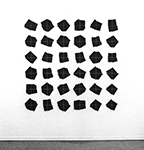Manfred Mohr "Divisibility, Generative Works, Part I, Works from 1980-1981", 1981
Galerie Gilles Gheerbrant, Montreal, Canada 10 Octobre - 3 Novembre 1981
|
THE HISTORY:
This workphase contains work from 1980-1981
Work from this workphase was shown at Manfred Mohr's one-person exhibitions:
- Manfred Mohr - Divisibility, Galerie Gilles Gheerbrant, Montreal, Canada, 10. Oct - 3. Nov 1981
- Manfred Mohr - neue arbeiten , Galerie Mueller-Roth, Stuttgart, Germany, 5. Mar - 3. Apr 1982
- Manfred Mohr - Divisibilité, Galerie Pierre Weiller, Paris, France, 25. Mar - 30. Apr 1982
- Manfred Mohr - Premieren, Galerie Heinz Teufel, Cologne, Germany, 26. June - 25. July 1982
- Manfred Mohr - Computerized Aspect of the Hyper-Cube, Art Research Center, Kansas City, Mo., April 10 - May 12, 1983
|
THE ART WORKPHASE:
- In this workphase, Manfred Mohr returns to the 3 dimensional cube. He creates multi-part structures and shaped canvases which use windows and cuts to show the tensions between independent rotations of the cube. He creates surface and line interactions with rotations of the cube.
- This workphase contains work from 1980-1981.
- This workphase introduces the 4-cut and out-lines/in-lines (surface/linear signs) paradigm and extends the cuts and windowing of Cubic Limit II (1977).
- The first part of this catalog shows the 2-cut of Cubic Limit II (1977) with very thick lines which approach surfaces.
- The next part of this catalog shows a 4-cut, with inside/outside - black/gray lines, which are moved in incremental alternating horizontal and vertical steps into overlapping positions.
- The last part of this catalog introduces the 4-cut, a cube cut through its origin into 4 parts by the cartesian x and y axes, where 3 of the 4 parts have an independent rotations, and the 4th part matches its opposite rotation, to create a visual balance. The workphase emphasizes the outer form (surface)
of the 4-cut as well as the inner lines, thus creating the out-line/in-line paradigm. The horizontal and vertical cut emphasizes the tension between the independent rotations.
- Surfaces are achieved in the drawings with 2 overlaying pieces of paper each with a different part of the drawing on it. The bottom paper has the out-lines filled in with black ink. The top paper has the in-lines. Thus the 2 overlayed (slightly transparent) papers form the "surface/linear signs" paradigm.
- Multi-layered drawings, multi-part reliefs, series of multi-part reliefs, matrices of multi-part reliefs are created on canvas and in wood.
The out-lines become the shape of each part of the object (surface) and the in-lines are drawn on the canvas of each part.
|
 Complete exhibition catalog (english, french, german)
Complete exhibition catalog (english, french, german)
|
 Invitations Invitations
|
 1981 - 1982 press about the shows
1981 - 1982 press about the shows
|
|
|
Some other artworks using the algorithms from this period 1980-1981
|

Wooden wall structure in 144 parts, P 300-AA, 1980
|

Series of 5 paintings, P-335A, with a sequence of overlaying quarter width moves (alternating horizontally and vertically), 1980
|

2-D projections of 3-D "Four-Cut", XY, XZ, YZ, 1980-85
|

Series of 5 4-cut structures, P-308, with rotating cut axis, 1980 - 92
|
|
 Complete exhibition catalog (english, french, german)
Complete exhibition catalog (english, french, german)
 Invitations
Invitations
 1981 - 1982 press about the shows
1981 - 1982 press about the shows Photos
Photos


